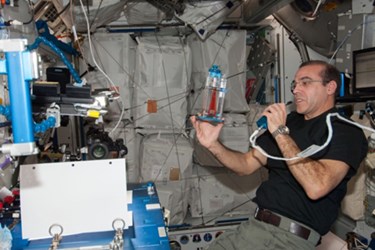Space Station Research Yields A New Disease Diagnostic Device
By Joel Lindsey

Researchers from Northwestern University and Portland State University have devised a new, sustainable, and highly portable disease diagnostic device that capitalizes on the principle of capillary flow, a concept tested and refined aboard the International Space Station.
In order to provide a diagnosis, cell samples of bodily fluids, like blood, are placed inside the device, where a specialized enzyme ruptures the cell bodies and releases the RNA and DNA they contain. The RNA and DNA are collected on a small bead, and another solution washes away everything else. The isolated beads of RNA and DNA can then be used to quickly and effectively detect any viruses that might be present.
“You only need fewer than a dozen particles, and you can detect the presence of the virus,” David Kelso, a researcher at Northwestern involved with the project, said in a press release published recently by NASA. “It’s a phenomenal analytical technique, but it involves four different fluids that have to be moved around.”
Kelso and the rest of the research team turned to capillary flow as a way of managing and directing the flow of these various liquids inside the device. According to NASA, capillary flow is an interaction between a liquid and a solid that forces the fluid to flow up a narrow tube. This phenomenon was extensively tested and refined in the low-gravity environment of the International Space Station.
“The capillary flow knowledge is just amazing,” said Kelso. “It’s a way to move fluids without putting any energy into the device. We were using motors and batteries and all these things that consume power to make the device work. Doing it with capillary action uses much less energy.”
It is the device’s low-energy capabilities, along with its effective testing results and relative ease-of-use, that researchers hope will make it particularly useful in conducting diagnostic work in remote or economically underprivileged areas.
“There are shortages of health care workers of all cadres, from lab technician to community health care workers, so the less constraint we put on the end user the better,” said Kara Palamountain, president of the Northwestern Global Health Foundation. “This wouldn’t necessarily require a lab technician or even a lab. It frees up a health care worker.”
Researchers involved with the project report that the device may be helpful in diagnosing specific infectious diseases like HIV/AIDS and tuberculosis. They hope to conduct field experiments in Africa later this year.
Image Credit: NASA
